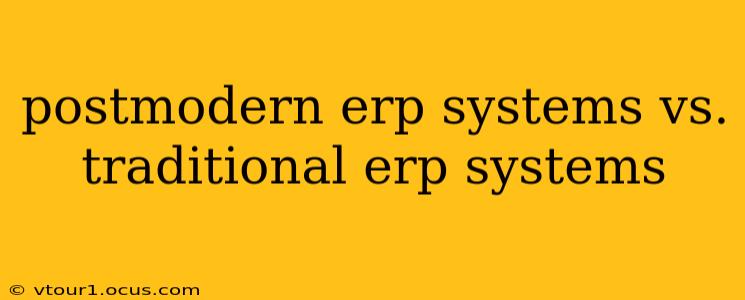Enterprise Resource Planning (ERP) systems have evolved dramatically since their inception. What was once a monolithic, rigid system designed for large enterprises is now available in flexible, adaptable forms tailored to diverse organizational needs. This article delves into the key differences between traditional and postmodern ERP systems, highlighting the advantages and disadvantages of each.
What are Traditional ERP Systems?
Traditional ERP systems, often associated with large, on-premise deployments, are characterized by their centralized architecture and rigid functionalities. These systems typically involve significant upfront investment, extensive implementation timelines, and a complex, often inflexible, configuration process. They focus on streamlining core business processes such as finance, human resources, and supply chain management within a single, integrated system.
Key Characteristics of Traditional ERP:
- Monolithic Architecture: A single, large system handles all functionalities.
- On-Premise Deployment: The software resides on the company's servers.
- High Upfront Costs: Significant investment in licensing, implementation, and ongoing maintenance.
- Complex Implementation: Long implementation cycles requiring specialized expertise.
- Limited Customization: Adapting the system to specific business needs can be challenging and expensive.
- Integration Challenges: Integrating with other systems can be difficult and require significant effort.
What are Postmodern ERP Systems?
Postmodern ERP systems represent a paradigm shift. They are characterized by their modularity, agility, cloud-based deployments, and focus on user experience. They offer greater flexibility, scalability, and cost-effectiveness compared to their predecessors. Instead of a monolithic system, they utilize a collection of interconnected, best-of-breed applications that can be tailored to meet specific business needs.
Key Characteristics of Postmodern ERP:
- Modular Architecture: Individual modules can be added, removed, or customized as needed.
- Cloud-Based Deployment: Software resides on the cloud, eliminating the need for on-premise servers.
- Lower Upfront Costs: Subscription-based models reduce initial investment.
- Faster Implementation: Cloud-based deployments and modularity accelerate implementation.
- High Customization: Systems can be easily adapted to changing business requirements.
- Seamless Integration: APIs and open architecture facilitate integration with other systems.
- Enhanced User Experience: Intuitive interfaces and mobile accessibility improve user adoption.
What are the Advantages of Postmodern ERP Systems?
The shift towards postmodern ERP offers several compelling advantages:
- Increased Agility and Flexibility: Easily adapt to changing market conditions and business needs.
- Reduced Costs: Lower upfront investment and ongoing maintenance costs.
- Improved Scalability: Easily scale the system to accommodate growth.
- Enhanced Collaboration: Cloud-based systems facilitate better collaboration across departments and locations.
- Better User Experience: Intuitive interfaces and mobile accessibility increase user adoption and productivity.
- Faster Time to Value: Quicker implementation and deployment lead to faster ROI.
What are the Disadvantages of Postmodern ERP Systems?
While postmodern ERP offers many advantages, it's important to acknowledge some potential drawbacks:
- Vendor Lock-in: Dependence on a specific vendor can limit flexibility in the long run.
- Security Concerns: Cloud-based systems require robust security measures to protect data.
- Integration Complexity (in some cases): While aiming for seamless integration, complex integrations can still pose challenges.
- Data Migration: Migrating data from legacy systems can be a significant undertaking.
What is the Difference Between Traditional and Postmodern ERP Systems? (Addressing a Common PAA Question)
The core difference lies in their architecture and deployment. Traditional systems are monolithic, on-premise, and require substantial upfront investment, while postmodern systems are modular, cloud-based, and offer greater flexibility and scalability at a lower cost. Traditional systems prioritize integration within a single, large system, while postmodern systems prioritize integration with various best-of-breed applications through APIs.
Which ERP System is Right for My Business? (Addressing Another Common PAA Question)
The choice between a traditional and postmodern ERP system depends on various factors, including your business size, budget, technical capabilities, and specific requirements. Small and medium-sized enterprises (SMEs) often find postmodern ERP systems more suitable due to their cost-effectiveness and flexibility. Large enterprises may still benefit from traditional systems in certain scenarios, especially where legacy systems are heavily integrated or security concerns are paramount. However, even large enterprises are increasingly adopting postmodern approaches for specific business units or functions.
How Much Does it Cost to Implement an ERP System? (Addressing a PAA Question)
The cost of implementing an ERP system varies greatly depending on the system's size, complexity, and the chosen vendor. Traditional on-premise systems usually involve high upfront costs, while postmodern cloud-based systems typically operate on a subscription model with lower upfront costs but potentially higher ongoing expenses. Factors like customization needs, data migration, and integration with other systems also significantly impact the total cost.
Conclusion
The transition from traditional to postmodern ERP systems marks a significant evolution in enterprise resource planning. While traditional systems still have their place, particularly in certain large enterprise contexts, the flexibility, scalability, and cost-effectiveness of postmodern systems make them an increasingly attractive option for businesses of all sizes. Understanding the nuances of each approach is crucial for selecting the right system to support your organization's growth and strategic objectives. Careful consideration of your specific needs and resources is paramount to a successful ERP implementation.
